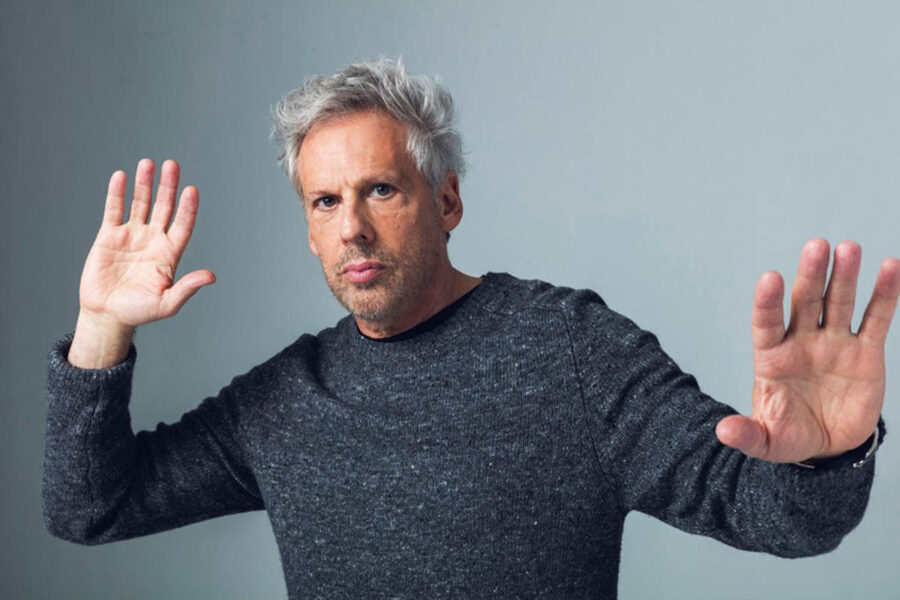
Sag Harbor resident, actor, writer, and teacher Josh Pais has spent decades exploring what it means to be fully present—on screen and in life. Known for his roles in Joker, Ray Donovan, the original Teenage Mutant Ninja Turtles, and many others, he has more than 150 film and television credits to his name. He has now turned his focus inward with his new memoir, Lose Your Mind: The Path to Creative Invincibility, which was released on September 30, 2025.
Drawing on his years of experience as founder of the Committed Impulse training method, Josh offers readers a bold invitation to release self-judgment, lean into all feelings, and connect with the spontaneous energy that fuels authentic creativity. His message—both playful and profound—challenges the myth of “good” and “bad” emotions and instead celebrates the full spectrum of human experience.
Josh will visit Sag Harbor for a reading and book signing this Sunday, October 12th from 4:00–5:30 p.m. at Grenning Gallery (26 Main Street, Sag Harbor). To attend, RSVP with your name and number of guests to [email protected].
Josh spoke about the inspiration behind Lose Your Mind, his creative and personal philosophy, and how learning to embrace discomfort has shaped both his work and his life.
What inspired you to write Lose Your Mind: The Path to Creative Invincibility?
JP: Two things. One: The book deal came to me. Seemingly out of thin air. There was even a bidding war for the book. As woo-woo as this sounds it felt like the universe was telling me, “Dude, write this book, and write it now. People need this.” This work is my gift to mankind. Does that sound arrogant? All I know is the principles in the book have already changed thousands of people’s lives. Two: For thirty years when I haven’t been doing a movie or TV show I’ve been teaching Committed Impulse. Committed Impulse training, which I founded, started out as a training for actors, but over the years people from all professions have been drawn to it. It gets people completely out of their heads, connects them to their body in a profound way, and opens the channel to their creativity. We all need this – especially now.
How would you describe the central message of the book?
JP: The biggest myth of our time causes a tremendous amount of angst. We see the impacts of this myth not only for the individual – but it plays out on the global stage as well. What is this myth? Simple. We have all been deeply immersed in the concept that certain emotions we feel are good and certain emotions we feel are bad. Typically, nervousness, fear, anxiety, sadness are on the bad list. Joy is on the good list.
Look, it is built into our DNA to feel emotions. It’s in our design. We’re going to FEEL as long as we are alive. Guaranteed. What if it’s all good? Trust me – it is! We need to recognize that emotions are atomic vibrations in our body. Emotions at their core are swirls of energy in our body. Sometimes we identify emotions as a chaotic pattern (anxiety), or more of a steady stream (calm). Sometimes the core of an emotion is a strong pulsation in our torso, an energetic contraction, or an expansion. What if none of it is bad? Or, for that matter – good. When we live in a human body we vibrate. We’re made out of atoms that are in a constant state of fluctuation. Have no doubt – it’s all there to help us. It’s creative fuel.
I’ve taught thousands of people how to make this shift. It’s not hard. The book will get you there. Once we get free of the good and bad emotional paradigm life becomes playful. There is an increased feeling of aliveness and energy in the body. And we don’t have to worry or brace ourselves against what we might feel. This is a key element to get us on The Path to Creative Invincibility.
How did your upbringing in 1970s Alphabet City shape your creative journey?
JP: I grew up on 7th Street between Avenues C and D, NYC. It was a drug world. (I’m sure a lot of you went down there back in the day to get your drugs.) Heroin and acid were the currency. If you lived in the hood you were protected – to a certain extent. But anyone else coming into the area from the outside was putting their lives at risk.
Amidst the chaos, it was also a highly (pun) creative area. This is where artists, like my mom, could afford to live. Everything was out in the open. People expressed themselves fully on the street. Nothing was held in.
Even though it was an intense place to grow up, I am so grateful for my experiences there. I was exposed to all kinds of wild characters. Many of whom I have drawn upon in roles I have done in film and TV. Plus, creativity was held as an important element within that culture. Well-known artists, musicians, and actors came out of that area at that time. It was an area of vibrancy and creative exploration. This passion to create instilled in me the importance of getting out of my way to bring my voice, my art, and my ideas forward.
Can you talk about your parents’ influence—and your other early influences that helped forge your path and experience?
JP: My dad was a theoretical physicist who worked with Albert Einstein, Oppenheimer, and Niels Bohr. When I was six years old I asked him what his job was. He said, “Joshua, do you see that table that is next to you?”
“Yes, of course I do. What is your job though?” I replied.
“And do you see your knee?”
“Yea…?”
“The smallest part of that table, and the smallest part of your knee are the same thing. Atoms. That’s what I explore – the building blocks of the universe.” He loaded his briefcase with his latest calculations and walked out the door. I was like woooooahhh. I looked at everything around me. It was trippy.
Years later, when I got out of acting school and started auditioning, I was paralyzed with nervousness, fear, and anxiety. But when I remembered this interaction with my dad, everything changed. I figured since my body is made from atoms then emotions must somehow be connected to atoms. I started welcoming all the sensations, as opposed to judging them. I explored converting the atomic vibrations in my body into creative fuel. Ya gotta ride it – not hide it. Once I started creating with all my sensations, instead of trying to manage or alter what I was feeling, I booked a Broadway play (I’m Not Rappaport) followed by countless movies and TV shows.
You’ve appeared in more than 150 films and TV shows—what have been the most transformative roles or moments in your acting career?
JP: My first lead role in a movie was playing Raphael in the original Teenage Mutant Ninja Turtles movie. Working in a 70-pound suit was grueling, but the experience was ultimately rewarding. Then working on Sex and The City as the Modelizer opened the door to more TV roles. And somehow started a string of roles as the horny guy. Create what ya know, I guess.
I have worked in the Law & Order franchises from the beginning, and had a great run on SVU until my character got thrown in jail. Playing Stu Feldman on Ray Donovan was another incredibly fun (if not fucked up) character. Working with Joaquin Phoenix on Joker (the first one) was a fantastic dive into spontaneity, and relishing in the unknown. The Dropout, playing the head of Walgreens, was a lovely ensemble experience as well.
What’s the story behind creating your Committed Impulse method?
JP: Early on in my acting explorations I realized that spontaneity was key to creating. But spontaneity seemed fleeting. I never quite knew when or why I would sometimes have access to it – and sometimes no access to it at all. So I went on a two-year journey training with people from all over the world who were exploring spontaneity and creating from impulse. I wanted to make spontaneity something I could count on in my work. After this journey, curiously, people started to ask me to teach. I told them I’m not a teacher. I don’t know how to teach. Then when NYU asked me to teach, I figured, what the heck. I stumbled into my first classroom, called what I was teaching, Committed Impulse, and thus began an amazing exploration. I really look at my workshops and classes as a laboratory to train people how to get out of listening to all their debilitating thoughts (it’s all in the book), and to profoundly connect to, and trust, their impulses, and sensations, in order to do their best work – regardless of their profession.
How do you see Committed Impulse helping people outside of acting?
JP: Committed Impulse teaches us how to speak from our most authentic place. This is not about tricks or techniques – it’s more about undoing ways of being that no longer serve us. And then grounding ourselves in presence. The results of doing this work are immense for everyone.
In this era that we are in, everyone is scanning for truth. And when anyone speaks from their truth – which the book teaches how to do – it instantly generates trust. Instantly your audience becomes engaged. And regardless of anyone’s profession we all have the equivalent of an audience. A lawyer, many of whom I have trained, doing a closing argument has a jury as an audience. A coach, doctor, teacher, public speaker, chef, artist, stripper, an actor all need to engage their audience. Lose Your Mind: The Path to Creative Invincibility teaches how to be absolutely compelling by revealing oneself as opposed to hiding behind a technique. By the way – this way of living, presenting, and creating is damn fun! In the book you’re going to learn simple practices. One of which is the 4 Access Points to Presence. Implementing these 4 access points 100% of the time will pull you into the present. This is one of the cornerstones of living a brilliant, creative, and playful life.
The book challenges conventional ideas about anxiety and presence. What do you hope readers take away about using discomfort as a tool?
JP: So many books and courses out there proclaim how to get rid of fear once and for all. How to eliminate anxiety forever. That’s not gonna happen, Boo, unless you endlessly suppress yourself one way or another. Instead of trying to get rid of natural body sensations and emotions we must EXPAND OUR TOLERANCE for all sensations. Welcome them. That’s mighty.
Whenever we have to go into high pressure situations – we are all going to feel more. This is natural. If we suppress ourselves in those situations, we will only diminish ourselves. If we are trying to hide a part of ourselves, how can others possibly connect to us?
Plus, and this is key, whenever we suppress ourselves in any way, we are signaling to our nervous system – I don’t want to feel you. And the more we disconnect from the body the more we end up connecting to our mind that starts telling us “No one likes you, you’re too fat, you’re failing, everyone else is getting ahead but you’re not because you’re so…”
I have to tell you, it’s much more fun (and is key to success) to feel your body than to listen to your mind telling you that you suck. We have to Lose Our Mind if we want to get on The Path to Creative Invincibility.
Do you have a favorite behind-the-scenes story from the set that made it into the memoir?
JP: There are so many stories in the book from behind the scenes with Robert De Niro, Meryl Streep, Edward Norton, Robert Duvall, and more.
I’ll tell ya something unexpected that Meryl did. We were working together for about three weeks in a high school in Harlem. The film, Music of the Heart, was directed by Wes Craven.
We were filming a scene between Meryl and I, and before she fed me her off-camera line, she had her back to me while the director of photography was finalizing the shot. When Wes called action, Meryl turned around to reveal she had secured a piece of scotch tape from the tip of her nose to her forehead. Always a great look. I think she did that partially to crack herself up and partially to remind me not to get too serious about the scene. Her unexpected move yanked me into the present, that’s for sure. We made it through the take at which point everyone on set cracked up. And even though it was a serious scene, that was the take that made it into the film.
What was the most challenging part of being vulnerable and sharing your personal story on the page?
JP: As I was writing, I practiced what I preach. So, if I felt vulnerable, I felt it, breathed into it, and let it guide me. Same with fear. From time to time my mind would start chattering some crap, “You don’t know the first thing about writing. You never got good grades in English class…” That’s when I used one of the tools in the book, “I’m back.” I said those two words out loud to pull myself out of my mind and returned to my body and kept writing. One word at a time.
How has living in Sag Harbor influenced your creativity and your work?
JP: This little area is loaded with creative people. Painters, artists, writers, musicians. I have so many friends that are passionate about their creativity, and being around them is a constant source of inspiration.
What do you love most about the East End community?
JP: The ocean, which I swim in year-round. I love going to Yoga Shanti, Channing Daughters Yoga, Grenning Gallery, The (creative center) Church at Sag Harbor, Provisions, Sag Cinema. It feels like a booming small town. And in August it is so exciting driving around the East End – you just never know who might cut you off.
What has been your proudest accomplishment so far—on or off the screen?
JP: Having a great relationship with my son, my girlfriend, and writing Lose Your Mind: The Path to Creative Invincibility. And yo – published by Penguin Random House/Hay House.
What’s next for you after the release of Lose Your Mind?
JP: I’ll be teaching in NYC in November. First time I’ve taught in person since the pandemic. You’re all welcome to come and play. And after this book tour I’ve been on, I’m looking forward to getting back into film and tv projects, working with creative, playful, spontaneous actors and directors.
Is there anything else you’d like to share with our readers?
JP: During these most unusual times ahead, we must do what we can to keep our creativity alive. We are in the midst of immense change and uncertainty – and the robots haven’t even fully arrived. We are all creative beings. We cannot let our creativity be diminished. Regardless of your profession, the more you have access to your creativity the more success and wellbeing are going to follow. Say hi if you see me on the street, or hit me up on Instagram.
To learn more about Josh, his book Lose Your Mind: The Path to Creative Invincibility, and Committed Impulse, click here.











